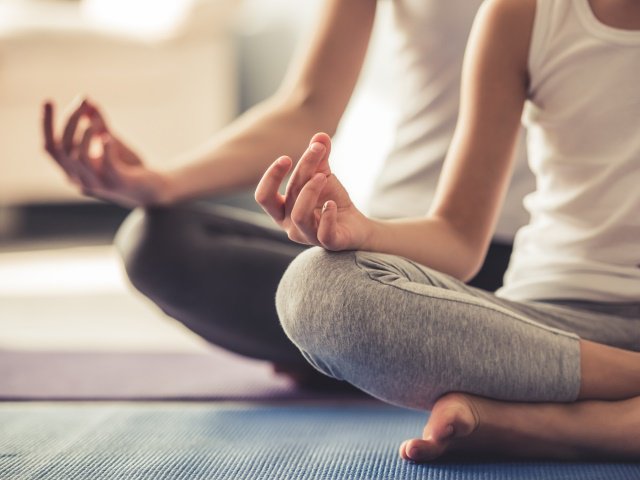
Different Forms of Yoga
Resources for You

Exploring Different Forms of Yoga and Finding What’s Best for You
Health Tips
When it comes to enhancing both mental and physical fitness, yoga offers an array of practices tailored to various needs and preferences, whether you seek an invigorating workout or soothing relaxation.
If you’re interested in yoga but don’t know where to start, keep reading this article as we explain the primary forms to help you figure out what interests you the most.
Ashtanga (aash-taang-guh)
Ashtanga consists of six series, each with its own set of poses. Think of these series as “levels” you must master to move on to the next one. It’s a flow-style yoga where you link every movement to your breath.
Important notes:
- It is intense, and it takes time to master.
- You can modify poses based on ability and move at your own pace.
- It involves spiritual components.
- Ashtanga enhances focus and discipline.
Bikram (bi-kruhm)
Bikram is similar to hot yoga (see below) but is very specific in class structure. It is a 90-minute session with 26 poses and two breathing exercises, always performed in the same order inside a 105-degree, 40% humidity room.
Important notes:
- Be sure to hydrate before practicing.
- It is not recommended for beginners or those not used to intense exercise.
- Many postures focus on correct alignment.
- Bikram is ideal for those who like routine and getting a good sweat.
Hatha (haa-thuh)
Hatha is the generic term for types of yoga that teach physical poses. Classes involve a mixture of poses and breathing exercises, as well as a variety of standing and seated postures to help you master the basics. It offers a relaxed and balanced session that works both the body and mind.
Important notes:
- It focuses on strength, relaxation and flexibility.
- Hatha is great for working on concentration.
- This type of yoga is best for beginners because of its slow pace.
Hot
Hot yoga is performed in a heated and humid room, as those who do it are looking for an intense workout. Unlike Bikram, instructors can choose their poses, order and room conditions.
Important notes:
- It is recommended that beginners find an easy version of hot yoga.
- It’s important to hydrate prior to class start.
- Studios are typically kept between 90- and 108-degrees Fahrenheit.
Iyengar (ai-uhn-gaar)
Iyengar sessions are very slow with little movement, as you are supposed to focus on precision and alignment while controlling your breath. These classes are best for relaxation, patience, mindfulness and mental clarity.
Important notes:
- Iyengar focuses on anatomy, movement and form.
- It is great for those with injuries; its slow movements are good for recovery, and you will still get a good workout.
- It includes the use of props — such as chairs, benches, blocks, straps, bolsters and walls.
- Iyengar is good for all skill levels due to its unhurried pace.
Kundalini (koon-duh-lee-nee)
This is a very spiritual form of yoga meant to bring out internal energy by challenging the mind and body. It involves intense breath work while performing repetitive physical exercises called kriyas. This spiritually oriented practice integrates meditation, chanting, singing and mantra.
Important notes:
- It fosters heightened self-awareness and spiritual growth.
- It’s best for those looking to cleanse their aura and negative energy and are interested in spiritual work.
- Kundalini is meant to relieve tension and unlock energy at the base of the spine.
Prenatal
A form tailored to expectant mothers, prenatal yoga classes prioritize pelvic floor work, breathing exercises and bonding with the unborn baby, aiding in preparation for labor and delivery.
Important notes:
- It utilizes props to enhance stability, with a focus on pelvic floor exercise.
- Prenatal yoga alleviates pregnancy-related pain and discomfort.
- It provides stress relief, exercise and self-care.
- New moms who just gave birth can also benefit from a class.
Restorative
This is one of the slowest and mellowest forms; sessions consist of only a few poses held for at least five minutes, sometimes up to ten. It is designed to tap into the parasympathetic nervous system to drift into a state of deep relaxation.
Important notes:
- It is great for those who experience insomnia and anxiety, as well as for athletes on recovery days.
- It makes use of props — such as blankets, bolsters and yoga blocks.
- A sub-form called Yoga Nidra helps you achieve consciousness between sleeping and being awake.
- Restorative poses require minimal effort, focusing on healing and mental rejuvenation.
Vinyasa (vuh-nyaa-suh)
It is also known as “flow yoga” or “vinyasa flow.” It involves fast-paced, almost nonstop movements with brief holding of poses. You are supposed to sync your breathing to move fluidly from one pose to the other.
Important notes:
- It is good for getting your heart rate up and is favored by endurance athletes.
- Some teachers will sync music rhythm with movements and poses.
- Vinyasa promotes concentration and body awareness.
Yin
Yin is another relaxed form that will help you calm down. You will hold poses for long periods of time, most of them while seated or lying down. It cultivates strength, stillness and patience.
Important notes:
- Poses may be held for up to five minutes.
- It is best for those looking to stretch and relax.
- Yin helps increase circulation in your joints and connective tissue to increase flexibility; it also targets ligaments, bones, fascia, hips, lower back and thighs.
- It uses props — such as blankets, blocks and bolsters.
Other Yoga Forms
Here are some other popular categories or sub-categories of yoga:
- Acro – Partner form that combines yoga and acrobatics
- Aerial – Involves the use of silk fabrics and ropes
- Anusara – Sub-form of Hatha yoga
- Jivamukti – Flow-style yoga that uses ancient teachings
- Kripalu – Another Hatha sub-form that focuses on life-force energy
- Power – For building strength and endurance
- Sivananda – Takes a holistic and spiritual approach
- Viniyoga – Focuses on connecting the mind, body, spirit and emotions
Resources
Begin your yoga journey with these helpful resources:
- Read Choose a Yoga Style to Fit Your Intention.
- Explore 31 Yoga Poses for Beginners.
- Discover popular yoga publications such as the OM Yoga Magazine, the Yoga Journal and Yoga International.
Remember to consult your doctor before starting any new exercise regimen.
Did you find this article interesting? Visit the American Independent Business Coalition online at aibcoalition.com to view more content like this!


